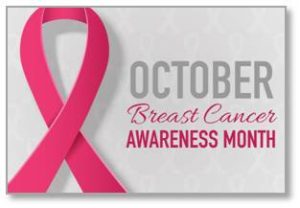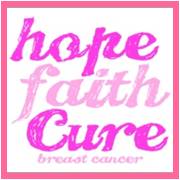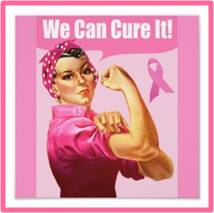October is National Breast Cancer Awareness Month
Monday Author: Susanne Skinner
Sixty years ago, 1 out of 3 people diagnosed with cancer survived. Today, thanks in part to the advancement of treatment options and the work of organizations like the American Cancer Society, 2 out of 3 will survive. Our goal is 3 out of 3.
 October is Breast Cancer Awareness Month. I am using this week’s blog post to give a shout out to all the men and women standing up to cancer and to all those we have loved and lost while fighting this disease.
October is Breast Cancer Awareness Month. I am using this week’s blog post to give a shout out to all the men and women standing up to cancer and to all those we have loved and lost while fighting this disease.
Besides skin cancer, breast cancer is the most commonly diagnosed cancer among American women. In 2016, it’s estimated that around 30% of newly diagnosed cancers in women will be breast cancers.
Women in the U.S. have a 1 in 8 (or about 12 percent) lifetime risk of getting breast cancer. This means that for every 8 women in the U.S. who live to be age 85, one will be diagnosed with breast cancer during her lifetime.
The survival rates for breast cancer depend on the stage the cancer is diagnosed. If it is diagnosed in Stage 1 or 2, the survival rate after five years is 100%. If it is diagnosed in Stage 4, the survival rate is 22%. The poorest prognosis is for metastatic breast cancer (stage IV), where the cancer has spread beyond the lymph nodes to other parts of the body.
Did You Know…?
In the United States, breast cancer death rates are higher than those for any other cancer, besides lung cancer. This year 245,000 new cases of invasive breast cancer will be diagnosed along with 61,000 cases of non-invasive (in situ) breast cancer.
An estimated 40,450 women in the U.S. are expected to die in 2016 from breast cancer, though death rates have been decreasing since 1989. Women under 50 have experienced larger decreases due to the result of treatment advances, earlier detection through screening, and increased awareness.
Men get breast cancer too, although it is rare. A man’s lifetime risk of breast cancer is about 1 in 1,000. In 2016, 2,600 new cases of invasive breast cancer are expected to be diagnosed in men.
Breast Cancer: A Family Affair
Breast cancer is a disease that has reached its tentacles deep into my family. A woman’s risk of breast cancer nearly doubles if she has a first-degree relative (mother, sister, or daughter) who has been diagnosed with breast cancer.
 In my family, it was my maternal grandmother; two of her sisters, three of her daughters, and now my own sister who battle this insidious disease. Estimates are that 15% of breast cancer is genetic, so the other 85% of breast cancers occur in women who have no family history. These occur due to genetic mutations as a result of the aging process rather than inherited mutations.
In my family, it was my maternal grandmother; two of her sisters, three of her daughters, and now my own sister who battle this insidious disease. Estimates are that 15% of breast cancer is genetic, so the other 85% of breast cancers occur in women who have no family history. These occur due to genetic mutations as a result of the aging process rather than inherited mutations.
A family history of breast cancer is the disease that keeps on giving. The absolute risk of breast cancer is much higher for women who have inherited mutations in the genes known as BRCA1 or BRCA2. Given our family history all of us had the test. Mine was negative.
Breast cancer that is positive for the BRCA1 or BRCA2 mutations tends to develop more often in younger women. An increased ovarian cancer risk is also associated with these genetic mutations. In men, BRCA2 mutations are associated with a lifetime breast cancer risk of about 6.8% and BRCA1 mutations are a less-frequent cause of breast cancer in men.
Woman who have this mutation are at a 55% to 65% higher risk for developing breast cancer by age 70. This means that out of every 100 women who have this mutation, anywhere from about 55 to 65 of them can expect to develop breast cancer should they live to age 70. For women with a BRCA2 mutation, the risk is a bit lower, at 45
Race for the Cure
 While we have no cure for breast cancer we are making strides with more treatment options and more targeted therapy. Knowledge is a key factor in early detection and treatment. The five-year relative survival rate for women with stage 0 or stage I breast cancer is close to 100%. For women with stage II breast cancer, the five-year relative survival rate is about 93%.
While we have no cure for breast cancer we are making strides with more treatment options and more targeted therapy. Knowledge is a key factor in early detection and treatment. The five-year relative survival rate for women with stage 0 or stage I breast cancer is close to 100%. For women with stage II breast cancer, the five-year relative survival rate is about 93%.
We don’t understand the disease well enough to know for certain which cancers will come back and/or spread, and which cancers will not but many breast cancer survivors are celebrating 10, 20, 30 or more years of being cancer-free.
Knowledge is Power
The best defense is to be informed and to know your own body well enough to notice even the slightest change. There are several exceptional web sites to help navigate the details and treatments for breast cancer. The American Cancer Society, mentioned previously, as well as the Komen Foundation comes highly rated by Charity Navigator for their information, research, fund raising and transparency.
Another great resource is Dr. Susan Loves Breast Book, updated in 2015 and considered the bible for those researching opinions and treatment options.
Boston’s local hero and cancer survivor Ellie Anbinder, founded Art beCause, an organization dedicated to funding scientific research to find the cause of environmental breast cancer and to educate the public on prevention.
Everyone’s journey is unique, and everyone knows someone who is fighting this battle. I am with you. I cheer for you, pray for you, cry with you and admire your bravery and courage. You are heroes among us.
The National Breast Cancer Foundation is offering
this free book on breast health.
